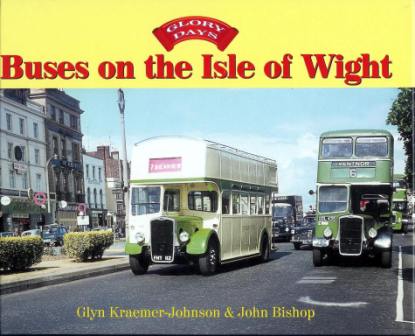
GLORY DAYS: BUSES ON THE ISLE OF WIGHT
BOOK REVIEW - TERRY KEMPSHALL
|
|
GLORY DAYS: BUSES ON THE ISLE OF WIGHT |
Glory Days - Buses on the Isle of Wight
Glyn Kraemer-Johnson & John Bishop
ISBN 0-7110-3114-2 - 245mm x 190mm - 96 pages - Hardback
Illustrated in colour and monochrome
Published in 2006 by Ian Allan
Before deciding what to write, I found myself asking what it is that persuades me to buy this kind of book? What do I look for and how do I decide if it represents value for money?
There are probably several key factors – does it cover an operator or operators with which I am, or was, familiar? Does the content focus mainly on the historical development of the fleet(s) themselves or on the people involved. My preference is for the buses. I have rejected a number of books in the past where I have felt too much emphasis has been on the boardroom activities rather than the vehicles (or where, having bought it, I have been disappointed by the content for the same reason). Finally, do the photographs adequately cover the many vehicle types likely to be involved, both the familiar and the less so?
 My
familiarity with the Island and its buses goes back to the very early 1950’s. I
think my first trip to the Island was in 1950 – and incidentally it was on that
day that I have my one and only recollection of travelling on a lowbridge
Southdown TD. That was followed that same day by my first trip on a lowbridge K,
on the Island.
My
familiarity with the Island and its buses goes back to the very early 1950’s. I
think my first trip to the Island was in 1950 – and incidentally it was on that
day that I have my one and only recollection of travelling on a lowbridge
Southdown TD. That was followed that same day by my first trip on a lowbridge K,
on the Island.
Association with the Island continued on a regular basis through family holidays during the 1950’s and 1960’s with a break in the early 1970’s. Those holidays were resumed with my own family in the 1970’s through the 1980’s and early 1990’s. My last visit was two years ago.
In common with several of the Glory Days series from Glyn Kraemer-Johnson and John Bishop (fast becoming my favourite authors of these books), the Isle of Wight book concentrates mainly on the Island scene from 1929 until 1969. But, in this instance, goes on to cover also some of the more recent developments - the final chapter being entitled ‘And so to Bed – with Go-ahead!’ The book also departs from the tighter scope of many of the Glory Days series. It embraces, as the title suggests, not only the main Island operator - Southern Vectis, but also the other main independent bus and coach providers such as Seaview Services, many of whom progressively fell under the ownership of Southern Vectis over the years.
The opening chapter covers the period when the Southern Vectis fleet was entirely single deck with the likes of Tilling Stevens, Dennis and Bristol chassis in evidence. It was not until 1936 with the delivery of a batch of Dennis Lancet II’s that double deckers began to enter the fleet in earnest. The text takes us through the subsequent eras of pre-war, wartime and post-war deliveries and activities with one chapter devoted entirely, much to my delight, to open-toppers.
I felt very satisfied by the black and white and colour photographic coverage. There are the ‘to be expected’ views of the Bristol marques of Southern Vectis, both supplied new and second-hand, but supplemented by their OB’s SB’s and VAL’s so peculiar to their Island needs. Then, there are the much remembered Leyland bodied PD’s of Seaview Services and their ex-Rochdale Craven’s bodied AEC Regent acquired to back up the PD’s on their regular Seaview route in busy periods. I was particularly pleased to see this bus feature in the photo coverage, albeit in black and white.
Elsewhere, views are included of some of the many non-standard coaches that found their way to Southern Vectis through various independents, such as a Harrington bodied Commer Avenger and a Dennis Lancet III, both in full SV coach livery and both ex-Nash of Ventor; and a Duple bodied SB, again in SV livery, that arrived through Groves of Cowes.
A particularly interesting view for some might be that of the Willowbrook bodied VAL of Seaview Services. I must admit that the first time I saw this I looked aghast! It did look something of a brute and that impression is still well conveyed for me by the illustration.
Later photos cover the NBC period. These include an example of a Bedford SB in Fountain Coaches livery that Southern Vectis ‘somehow managed to continue painting … in orange and cream’ as the text observes, and the introduction of the Leyland Olympians in the 1980’s as the company moved forward to the present day and eventual Go-ahead ownership. However, these post NBC developments are only covered briefly.
The landscape of the Island, always attractive and often dramatic, is not overlooked and is clearly evident in many of the illustrations. The childhood impression that the sun always shone is well conveyed.
Did the book satisfy my three main requirements as set out at the start of the review? The answer to that is a resounding, ‘yes’. Did it go further and add to my knowledge of the island and the main operators and types, something that would be an added bonus? Again, the answer is positive.
The book can be thoroughly recommended as an addition to the library of those who were/are already familiar with the Island bus scene over the periods covered. For those who are not, I suggest the book will soon arouse your interest and also that for making the all important first visit. You won’t see K’s or LD’s any longer – or will you? The book does not neglect to make a reference to the Isle of Wight Bus and Coach Museum at Newport!
TBK